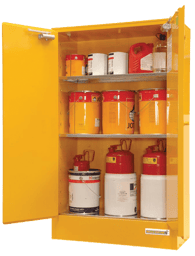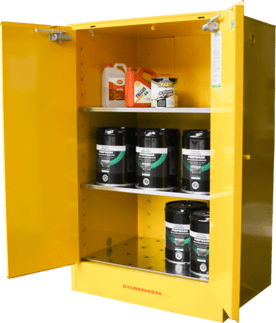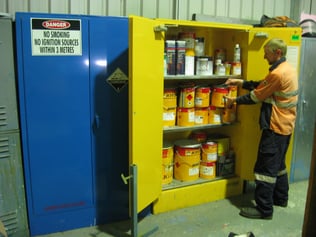Flammable liquids are some of the most common hazardous substances and they are used and stored almost everywhere. Whether it’s tins of petrol, paints or glue — it sounds like the contents of just about every garden shed in the country. However, if flammable liquids are stored at busy job sites, there are multiple risks that must be controlled in order to keep the flammable liquids safe and stable. From equipment that generates sparks and static electricity to heat, friction and flames, workplaces often have countless ignition sources that can cause flammable liquids to flash back, auto-ignite or explode. When this occurs, hazardous fires can burn rapidly and produce thick toxic smoke — which can consume the workplace, the organisation and the wider community. To minimise the risk involved with the use and storage of Class 3 Flammable Liquids, businesses should keep even small quantities of these dangerous goods in a flammable cabinet. In this blog, our Dangerous Goods Specialists share some of their expert tips on how to choose an indoor flammable liquids cabinet for your workplace.
IMPORTANT: Flammable liquids cabinets that have been manufactured according to AS1940:2017 –The storage and handling of flammable and combustible liquids are safe, reliable and fit-for-purpose.
Tip #1. Cabinet Construction
When selecting a flammable cabinet, your first consideration should be the cabinet construction. Things to look out for are the quality of the construction materials, the design and construction of the shelving, and the reliability of the componentry.
An indoor cabinet that meets the guidelines of AS 1940:2017 is made from double-walled sheet steel and has a space of at least 40mm between the walls. If this space is filled, the insulation must be non-combustible.
All componentry like gaskets or hinges must be of high standard, and not melt or fail at temperatures below 850°C.
Cabinet doors are to be close-fitting and gaps must be sealed off so that flames or radiant heat can’t enter or escape the cabinet. It’s also essential that the doors can close automatically and will be held shut at two (or more) points.
IMPORTANT: We’ve developed a never-fail system that ensures the doors on our flammable liquids cabinets always close in sequence. It’s fully patented and we guarantee that the doors close properly every single time.
Flammable liquids cabinets must be constructed with perforated shelving that allows the free movement of air. This decreases the risk of flammable vapours building up inside the cabinet.
A further requirement of AS 1940:2017 is that the cabinet shelving be capable of carrying the maximum possible load. Compliant cabinets are constructed with sturdy shelving that meets the maximum load requirements for flammable liquids. You can find the maximum load capacity for your flammable liquids cabinet on the pre-installed signage that’s clearly displayed on the front of the cabinet. Just remember, it’s also important to fully train your staff and supervisors so that they never overload your safety cabinet.
Construction For Large Capacity Cabinets
Any flammable liquids cabinet that holds more than 250 litres of chemical is considered a large capacity cabinet — and has additional construction specifications. First, the exterior of the cabinet must be at least 1mm thick. Second, the cabinet must not stand taller than 2 metres from floor level.
Tip #2. Spill Containment
Your next consideration is ensuring the flammable liquids cabinet has a spill containment sump to catch leaks and seepage from broken or damaged containers. The spill sump must be 150mm deep, liquid-tight and located at the base of the cabinet.
 Your flammable cabinet should be constructed with a liquid-tight spill containment sump that can contain and control chemical spills.
Your flammable cabinet should be constructed with a liquid-tight spill containment sump that can contain and control chemical spills.
To maintain the integrity of the cabinet’s spill containment system, it must be clear from substances and materials. That means you should always inspect and clean out your spill containment sumps and never used them as a shelving or storage area.
Spill Containment For Large Capacity Cabinets
For cabinets over 250 litres, the spill containment sump must be able to hold at least 25% of the total capacity of the cabinet or the full volume of the largest chemical container that will be stored in the cabinet.
 If you require a flammable cabinet that’s over 250 litres, your spill containment sump must be able to meet the required capacities as stated in the Australian Standards.
If you require a flammable cabinet that’s over 250 litres, your spill containment sump must be able to meet the required capacities as stated in the Australian Standards.
IMPORTANT: Do you need an easier and safer way to clear away spilled chemicals? We’ve created flammable cabinets with a plug on the spill sump for the simple and safe clearing of your cabinet spill containment sump.
Tip #3. Marking and Signage
Another essential consideration is the marking and signage placed on a flammable liquids cabinet.
To meet the requirements of AS 1940:2017, the following signs and markings must be clearly visible when the doors of the flammable cabinet are closed:
- Class 3 Flammable Liquids (Dangerous Goods pictogram at least 250mm nominal length).
- ‘NO SMOKING, NO IGNITION SOURCES WITHIN 3 m’ (Warning placard with letters at least 50mm high).
- Maximum capacity.
- Name and address of the manufacturer.
- Name of distributor (for imported cabinets).
Tip #4. Additional Considerations For Flammable Cabinets
Now that we’ve outlined the three major considerations when you’re choosing a flammable liquids cabinet, we want to explain the importance of some additional considerations.
While these aren’t specific requirements of Australian Standards, these considerations do provide a superior standard protection for your Class 3 Flammable Liquids — and your organisation.
Cabinet Surface Finish
Australian workplaces can be harsh environments and a safety cabinet at a job site in the manufacturing, construction, mining or marine industries can quickly deteriorate if not protected with a quality powder coat finish.
We take great care to cover all the steel surfaces and components in a high-tech finish. The finish on the cabinets is corrosion free and is designed to keep looking good for years to come.
 When selecting a cabinet, we suggest considering the finish of the cabinet, its ability to resist wear and tear, and the overall quality of the manufacturing process.
When selecting a cabinet, we suggest considering the finish of the cabinet, its ability to resist wear and tear, and the overall quality of the manufacturing process.
Heavy-Duty Cabinets
If your flammables are being stored in a challenging environment, you may like to consider purchasing a heavy-duty cabinet.
Our heavy-duty flammable liquids cabinets are 25% thicker than standard flammable cabinets, so they can provide a more durable, long-lasting solution for safe chemical storage. The heavy-duty construction includes the walls, doors, shelving and supporting legs of the cabinet.
Quality Of Construction
When it comes to chemical compliance, the quality of the construction is an important consideration. You want to select a cabinet that’s safe, efficient and 100% compliant to Australian Standards and WHS Regulations.
Our team believe the key reason for our consistently high standards is that all of our products are designed and manufactured right here in Australia. By employing a team that includes in-house engineers and technicians, we can maintain complete quality control — along the entire supply chain.
Buying An Indoor Flammable Liquids Cabinet
Now that we’ve explained the step-by-step considerations for choosing an indoor flammable liquids cabinet, we hope we’ve made the process a less confusing and daunting task. If you’re looking for a better way to store Class 3 Dangerous Goods, we invite you to download out eBook Essential Considerations When Storing Flammable Liquids Indoors. This handy guide will give you a better understanding of how to assess your compliance obligations. It also details the essential requirements when installing and maintaining a flammable liquids cabinet indoors.
Joining the team as a Dangerous Goods Storage Consultant, Melissa Hampton became Storemasta's Marketing Manager in late 2021. With extensive knowledge and experience in chemical compliance, Melissa is responsible for leading the Marketing team and helping shape their marketing strategy. In her spare time, you can find Melissa hiking, swimming and enjoying the great outdoors in beautiful north-west Tasmania.
